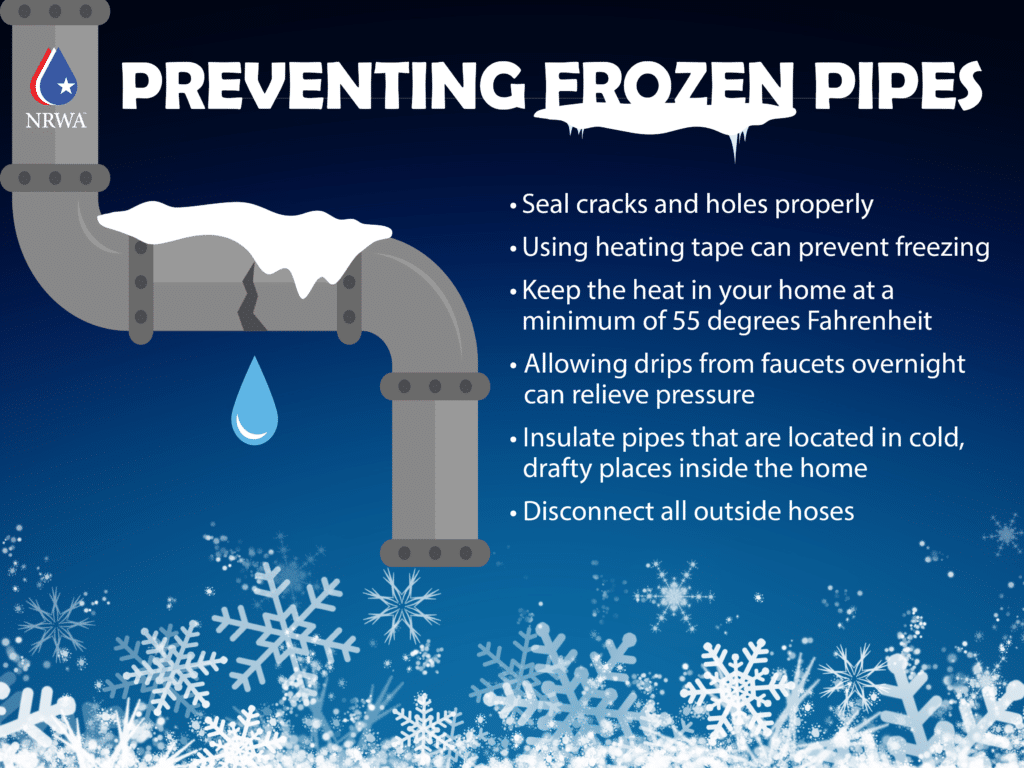What Causes Pipes to Freeze?
Sudden drops in temperature below 32°F expose pipes to freezing conditions. These abrupt changes are especially problematic in regions where winter temperatures often fluctuate significantly. Unheated spaces, such as basements, crawlspaces, and walls facing the exterior, often contain pipes that remain at lower temperatures due to the lack of direct heating. Stationary water inside pipes freezes more easily. When faucets aren’t used frequently, water stagnates, increasing the chance of freezing during cold weather.
Signs Your Pipes Are Frozen
No Water or Low Water Pressure
A faucet that produces no water or has significantly reduced water pressure often indicates ice blockage inside the pipe.
Frost on the Pipes
Frost or ice on exposed pipes, commonly seen in basements or attics, signals frozen water is present inside.
Unusual Sounds
Whistling, banging, or clanging noises occur as water struggles to flow past an ice blockage in the pipe.
Unpleasant Odors from Drains
Trapped odors may arise from frozen pipes blocking proper drainage.
Bulging Pipes
Swollen pipe sections appear when ice expansion causes the pipe to stretch, increasing the risk of a burst.
Leaks or Water Damage
Water stains, drips, or pooling water near walls, ceilings, or floors suggest a pipe may have ruptured due to freezing.
How to Fix Frozen Pipes
Locate the Frozen Section
Identify the area where water flow has stopped, focusing on faucets with no or reduced output. Check unheated or exposed spaces like crawlspaces, attics, and basements where pipes are more likely to freeze. Inspect for visible frost or bulging areas on pipes.
Apply Heat to the Pipe
Warm the pipe gradually using safe methods. A hair dryer or heat gun can be effective; keep the device moving and avoid prolonged contact to prevent pipe damage. Wrap the pipe with electric heating tape, which provides consistent warmth. For localized freezing, apply towels soaked in hot (not boiling) water.
Open Faucets
Turn faucets on slightly and let water drip while applying heat. Flowing water helps melt ice by reducing pressure buildup and lowering the risk of pipe bursts.
Avoid Dangerous Methods
Never use open flames, blowtorches, or extreme heat sources; these can damage pipes or cause fires. Stick to safe heating techniques to prevent additional property damage.
Monitor for Leaks
As water starts flowing again, inspect pipes for cracks or pinhole leaks caused by ice expansion. Shut off the water supply immediately if any leaks are found.
When to Call for Professional Service
Identifying situations that require professional services is essential to prevent further damage. When certain issues arise, immediate action ensures safety and avoids costly repairs.
- Hidden or Inaccessible Pipes: If I can’t locate frozen pipes because they’re behind walls, floors, or ceilings, professional thermal imaging or inspections can efficiently identify the problem.
- Failed DIY Thawing Attempts: When pipes remain frozen after trying safe DIY methods, professional intervention may resolve the issue without risking pipe bursts.
- Visible Leaks or Bursts: Signs like water stains, active leaks, or wall damage indicate a need for emergency plumbing services to address water damage and repair damaged pipes.
- Persistent Freezing Issues: If pipes freeze repeatedly, upgrading insulation or installing heating solutions, such as HVAC systems in unheated spaces, may be necessary to prevent future incidents.
- HVAC System Problems: When my heating system fails to keep pipes warm enough, contacting HVAC professionals ensures adequate performance and avoids the risk of frozen pipes.

Preventing Frozen Pipes in the Future
Protecting your home from frozen pipes is all about staying proactive and prepared. By understanding the risks, recognizing early warning signs, and knowing how to respond, you can safeguard your plumbing and avoid expensive repairs.
Winter’s challenges don’t have to catch you off guard. A little effort now can save you a lot of trouble later, keeping your home safe and your water flowing no matter how cold it gets.
